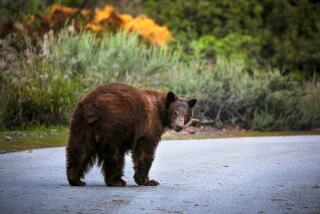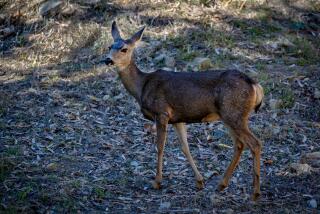Hunting Bighorns: Sport or Murder? : It’s a Lot More Than Just a Game
- Share via
BAKER, Calif. — Rolling slowly up a desert canyon in 4-wheel drive, visitors see a bighorn sheep bound across the trail.
The ram--a young one, judging by its limited horn development--continues up the loose shale of the steep south slope without breaking stride, sure-footed and swift. Several ewes are there, watching the intruders but seemingly uncertain what to do. Soon, the ram sizes up the situation as a threat and leads the group over the ridge and out of sight.
For the record:
12:00 a.m. Dec. 8, 1988 For the Record
Los Angeles Times Thursday December 8, 1988 Home Edition Sports Part 3 Page 12 Column 5 Sports Desk 2 inches; 46 words Type of Material: Correction
In a photograph in Wednesday’s editions, Daniel Whaley was incorrectly identified as a member of Hunt Saboteurs, a group trying to disrupt the bighorn sheep hunt in the Mojave Desert. Whaley, an attorney for two of the activists, is not a member of the group and was at the site to serve lawsuit papers in regards to last year’s hunt.
The intruders get back into their truck and turn right, up into a side wash to scan the other side of the hill, but by now the sheep have crossed over the wash and are on the left ridge, silhouetted against an overcast sky.
Then the problem becomes clear. A lone ram is seen back on the north slope. Still as stone, he is waiting and watching for the first ram to bring the ewes over to safety. It’s mating season.
Finally, the first ram plots a route far up the canyon and leads the ewes cautiously down the slope, across the level ground in a burst of speed and up the other side, where they pick their way through the boulders and gullies back to the waiting ram.
Anyone watching this living desert drama comes to understand the appeal bighorns have for outdoorsmen--hunters and non-hunters alike--as an agile, intelligent animal that can make some of the world’s harshest environment its home.
Hunters prize their massive, curling horns for Boone and Crockett points--the scoring system, according to James Morgan, writer and former Idaho state wildlife biologist, that was created by the club founded by Teddy Roosevelt in 1887 “to promote manly sport with a rifle (and) work for the preservation of the large game of this country.”
Hunters have no trouble reconciling the two goals that to others seem at cross-purposes. Anti-hunters can’t understand how you preserve something by killing it.
To hunters, it is big-game sport--find an animal, stalk it, shoot it, score it, mount it. Loren Lutz, a retired Pasadena dentist who is president of the Society for the Conservation of Bighorn Sheep, a pro-hunt group, described the challenge of hunting bighorns:
“If you’ve seen the sheep, he’s seen you. His eyesight is 8 to 10 times better than a human’s. If you’ve seen him with your binoculars, he’s probably seen you. If you’ve seen him with your (high-powered) spotting scope, he may have seen you.”
Others prefer to admire the bighorn for its living magnificence--find it, stalk it, photograph it, frame it--not mount its head and horns on a wall.
No bighorns had been killed through Monday, but the special desert hunt for eight hunters who won permission in a state lottery will continue through Dec. 18 and the two sides’ common obsession with the species remains sharply divided by life and death philosophies. One side’s game management is the other side’s murder.
At issue during the current 2-week hunt at two ranges in the eastern Mojave Desert is the future of the desert, or Nelson, bighorn, and it has brought out all the arguments that will always alienate hunters and animal lovers.
The animal lovers cite “the corruption inherent in the (Department of Fish and Game) management structure” for throwing in with the sheep hunters--apparently oblivious to the fact that the DFG is in the hunting and fishing business.
Of concern to several law enforcement agencies overseeing the hunt is that emotions are running so hot that a human being might get seriously hurt. According to the activists, there already have been several incidents.
Read the stated aims and objectives of the Hunt Saboteurs, who are leading the campaign:
“We are not prepared to stand aside while the blood lust of a few Americans runs rampant in the wilderness. . . . These blood sports will be stopped even if it means putting our lives on the line.”
Does that sound like a basis for reasonable negotiations? Blowing airhorns to frighten the bighorns, stalking the hunters as they stalk the sheep, the activists are trying the patience of the men with the guns.
In other little desert dramas played out already:
--An activist accused a hunter’s companion of firing warning shots over his head with a handgun.
--The activists, who ordinarily are avoiding law enforcement personnel, felt compelled to call in the San Bernardino County Sheriff’s Dept. to search for one of their number, Rick Bernardi, 33, of San Jose, who had been missing in the Marble Mountains for 24 hours and later said he was “chased all night” by a helicopter and all-terrain vehicles.
--Another activist, Robert Nanninga of San Diego, said a hunter and his guide threw rocks down on him from above and tried to chase him over a ledge toward a 600-foot drop.
“They weren’t small rocks, either,” Nanninga said. “They were the size of cantaloupes. They told me to ‘come up and give us your airhorn.’ ”
Nanninga chose to run.
He said: “We’re trying to be as peaceful as possible. I would rather have stood my ground, but that hasn’t been our strategy.”
Those reachable on the pro-hunting side either denied the accusations or said they had no knowledge of any such incidents.
When Bernardi was reported missing, Nanninga said: “We’re not sure he’s lost. We think he may be hurt.”
Hurt, Nanninga meant, not necessarily by accident, and now it seems the activists’ strategy will be to become more aggressive. Nanninga hopes to see the hunter who he says threw rocks at him again.
“Every time I see him, I’m going to be right on his tail. We’re planning to be more confrontational. We’re wasting our time trying to be inconspicuous. We’re going to bird-dog these hunters. We’ll just walk behind ‘em. We’ll run if they come at us--or, who knows, we may not run.”
Bernardi was found Monday--10 minutes after sheriff’s deputies started their search.
“The Highway Patrol picked him up walking down the middle divider of the (Interstate 40) freeway,” Deputy Fred Wegner said. “He was a little dehydrated. Said he ran out of water Sunday afternoon.”
Bernardi said he was trying to come down a hill after dark when he almost fell over a ledge, so he started down the other, less precipitous side near the hunters’ camp.
“Apparently, they heard me,” Bernardi said. “They jumped into trucks and lit up their whole camp with floodlights.”
DFG wildlife biologist Dick Weaver, told of the incidents after returning from the desert to his Sacramento office Tuesday, said, “I don’t know where the truth lies, (but) I can understand one of those (hunters) getting that exasperated.”
The 30 or so activists may get little sympathy from the hunters, but their hardships are undeniable. They are long on zeal but short on gear, and sometimes their planning seems haphazard, although they are trying to tape all encounters with video cameras.
They use a motel room in Baker as a communications command post.
The activists had planned to keep in touch with their people in the hills by hand-held radios but failed to make contact at scheduled times.
Typically, the activists who are scattered through the two ranges spend 2 or 3 days in the hills, then come in for a break while others take their places. The DFG has been using its Long Beach-based airplane to monitor movements.
The DFG points out that the activists have chosen a poor battleground to fight their noble cause because the lives of only 8 sheep from an estimated 4,700 in the state are at stake.
By comparison, Nevada and Arizona have allowed bighorn hunting since the ‘50s and their populations have grown dramatically to 5,500 and 3,400, respectively. They issued 142 and 78 permits for their current hunts. with no anti-hunt activists apparent.
“That (8) is really an insignificant number, considering the mortalities from other causes (such as) disease, predators and natural causes,” Weaver said.
But the activists say it’s only a start to make the law’s 5-year trial period look good. They say they intend to make a stand here and now, at any cost.
More to Read
Sign up for The Wild
We’ll help you find the best places to hike, bike and run, as well as the perfect silent spots for meditation and yoga.
You may occasionally receive promotional content from the Los Angeles Times.






